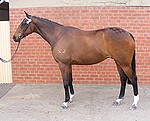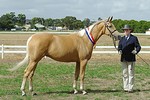Jeanette Gower copyright © . Updated Sept 2012.
Jeanette is available for lecture tours & clinics.
Coat colour testing is available: See Animal Genetics
Coat colour predictor: See Animal Genetics Coat Color Calculator
| The study of genetics enables us to determine how certain characteristics are passed on from parent to offspring. Genes are chemicals which are arranged in a particular pattern in the DNA which make up the chromosomes. Each gene has its own position or locus on a particular chromosome and, since chromosomes come in pairs, so do genes. If these two genes are not the same the horse is said to be heterozygous for that gene, but if they are the same, the horse is said to be homozygous for that gene. The importance of this is in predicting outcomes of matings. |
|
Original Moncler Moins cher Prix Bas Moncler Soldes Reduction Original Moncler Soldes Moncler Femme Pas Cher Original Moncler Petit prix Femme Prix Bas Moncler Soldes authentic cheap jerseys from china wholeslae cheap jerseys from china cheap jerseys china
Base ColoursHorses have four basic colours: chestnut, bay, brown and black which are produced by the combinations of agouti (A) and extension (E) genes. These are readily identifiable by DNA testing. Further alleles may be discovered in the agouti range, which may explain the apparent discrepancies in colour prediction of matings between bay, brown, black and chestnut. Brown is presently considered recessive to bay, though only one lab is able to test for this. |
|
Extension Series
|
|||
|
Table 1
|
E_ | ee | |
|
Agouti
|
A__ | Bay | Chestnut |
|
Series
|
A+_ | Brown | Chestnut |
| aa | Black | Chestnut | |
|
Patterns and dilutions are produced by the presence of other genes in other positions. These can have the effect of:
|
DilutionsDilutions affect the base colours outlined above. There are five types: Cremello locus (cream) Ccr which has intermediate effects, the Dun D, Taffy Z (which are simple dominants), Champagne Ch, and more recently, Pearl. The effect of Ccr is limited on black pigment and its effect varies from horse to horse. The single dilutes can never become a colour breed as their genes cannot reach purity or homozygosity. This family includes the palominos and buckskins. For example, mating two palominos together can never guarantee a palomino foal. There are plenty of example photos of these colours in Horse Colour Explained. In Australia, Dilutes Australia Pty Ltd, recognises and registers all Dilute horses including taffies, champagnes and pearls of all breeds. Please see their website for more detailed descriptions of the colours. http://www.dilutesaustralia.net |
|
sire: Palomino
|
|||
|
Table 2
|
C | Ccr | |
|
dam:
|
C | Chestnut | Palomino |
|
Palomino
|
Ccr | Palomino | Cremello |
| The yellow, or standard dun colour, is often confused with buckskin, however duns are characterised by having a face mask, primitive markings and bold dorsal stripe running from mane to tail. Dun on a black base gives blue dun (grulla). Yellow dun mimics buckskin. Dorsal stripes may be present in all colours as counter-shading and in foals, so its presence alone, is not proof of the dun gene. Homozygous champagne and dun do not produce a psuedo-albino like the cremello dilution (CcrCcr). Duns and taffies are most commonly seen in Miniature Horses, Quarter Horses (duns), Australian breeds (taffies) and the Connemara. (See table 3). The Taffy gene (sometimes known as Silver) has limited effect on red pigment, but changes black pigment to chocolate giving the silver dapple on a black base and red taffy on bay. Homozygous Taffy has been associated with an eye disorder called A.S.D. in which they may very rarely, be blind. Unusual colours such as the Claybank and Taffy Dun may occur when two or more dilutes co-exist as composites. The rarer Champagne colour mimics palomino and buckskin but has a wheaten skin. This is the only colour where pink skin does not produce white hair. Pearl on the other hand, is located on the same loci (C) as cream, so an individual horse cannot have two cream and two pearl genes. Pearl is very rare, and is found in the baroque breeds, such as the Andalusian, and breeds of the new world, such as the Saddlebred and Paint horse. For a full explanation and colour illustrations, I recommend the Dilutes Australia website http://www.dilutesaustralia.net |
| Table 3 | Action of the dilutes | |||
| Base CC (full colour) | Double CcrCcr (pseudo-albino) | Single CCcr (dilute) | Dun D_ | Taffy Z_ |
|
——————————————————————————————————————————-
|
||||
| Chestnut | Cremello | Palomino | Red Dun | Chestnut taffy |
| Bay | Perlino | Buckskin | Yellow Dun | Red taffy |
| Brown | Perlino | Dark Buckskin | Mouse Dun | Dark taffy |
| Black | Smoky Perlino | Black Buckskin (or | Blue Dun )or | Black taffy (chocolate taffy or silver dapple) |
| smoky or dilute black) | grulla) | |||
PatternsPatterns as seen in Paints, pintos and roans are all dominant. The pattern genes include the following groups: Grey is born a base colour, whitening out with age. This pattern includes flea-bitten, dapple, blood markings, sometimes the influence of melanoma and pinky syndrome. It is possible to find and breed from lines which do not have these incidences, but this is also very breed dependent. 100% grey producers can be found and they must have both parents grey. True Roan is born a base colour mixed with white hairs, and has the darker head and legs of the base colour, which gives the colour its name. They do not whiten out with age like greys. Homozygous roans have been identified in some breeds, and there is conjecture that there may be several mutations for roan. Other colours sometimes incorrectly described as roan are sabino, heavy ticking, and varnish (spotting). Ticking is similar to roan but the white hairs are not as heavily distributed and are seen mostly in the flank, ribs and tail. Tobiano pattern consists of mainly vertical white patches. Homozygosity can occur and can be identified by laboratory test. This pattern is not associated with any disorders but sometimes there is a ‘blue eye’. Very rarely, tobiano is minimally expressed, most often in Shetlands, where the pony may appear to be solid. Overo (frame) has more horizontal patches. Homozygosity causes lethal white foal syndrome (OLWS) in the overo and very rarely, some non-coloured overos of pinto background. Therefore, before breeding any pinto (Paint, miniature etc) or horse of unknown background to an overo, it should be tested for OLWS. So too should non-coloured progeny of overos be tested before being bred. All overos are heterozygous carriers for lethal white so need not be tested, as it is a given by definition. Sabino shows as vertical patches, raggedy edges and V-pointed strips of white. It appears as an extension of the way in which normal white markings occur in most breeds. Several types have been identified with tests available, and some are more strictly classified as “dominant white”, the different types being reflected according to breed. Many sabino modifications have yet to be identified by DNA testing. ‘All-white’ homozygotes can occur. An extreme of sabino patterning is the ‘medicine hat’ which is either pure sabino, or a sabino combination. No disorders have been associated with sabino. Splashed White pattern is a rarer horizontal pattern found mostly in Paints and Minis, and the rarer European breeds. Recent studies have revealed three mutations and lab testing is now available for these. The classic pattern is of large bald face, white legs, both eyes blue and white dipped tail. Minimal markings or blue eyes are found in the heterozygote of certain identified patterns, in which the homozygote is fully expressed as classic Splash. Many have associated deafness due to the way the colour is formed during embryonic development; those with minimal colour appearing to be least affected. The most prominent Australian line, however, appears to contradict, demonstrating classic pattern and deafness in heterozygous form and homozygotes have not been found. There is no test yet for Australian Splash. Composites: All patterns may exist side by side in one animal as composites, producing anything from the extensively white ‘medicine hat’ or minimally marked horses. Those with incomplete markings may still carry the pattern gene but have insufficient white to be identified as a pinto. These ‘solids’ still carry the gene and cause ‘crop-outs’ in breeds which do not normally allow these patterns. Clones: Recent evidence using cloning of embryos has proven that there is much to learn about our understanding of white markings. It shows that identical genetic siblings can have different amounts of white and even on different legs! |
Spotted |
| Spotted patterns are seen in the Appaloosa, Knapstrub, Palouse pony, Pingauzer, Gypsy Cob and many other lesser known breeds. This pattern gene ( known as the Leopard complex) has at least four gene positions or loci involved, the exact mechanism of which is unknown but all are thought to be incompletely dominant. Gene Lp gives the ‘characteristics’ of mottling, white scelera, striped hooves and ‘bronzing’. In homozygous form it gives ‘varnish’ or ‘roaning out’ as the horse matures. Lp must be present for all other spotted characteristics to appear. Hence some horses with spotting genes may not be coloured but still produce colour even when bred to a horse with minimal characteristics. Males colour up more readily than females. For a complete and up-to- the minute treatise on the inheritance of spotting, go to http://equinetapestry.com The following patterns are described and may occur singly although more commonly they coexist: Dark spots – produces the spotting on blanket, near leopard and true leopard. Varnish – gives a progressive ‘silvering’ of white hairs similar to roan, with dark hairs remaining around bony prominences. When combined with dark spots it may give the ‘false leopard’. White blanket – also known as snowcap, gives white patching over the rump, or sometimes over most of the body and when homozygous, the ‘few spot’. The few spot produces 100% spotted and is associated with night blindness. White spots – gives frost on the rump or snowflake over the entire body. Other colours and patterns: Modifying genes exist such as those which produce smuts, dapples, sooty, flaxen, pangare, marble markings, brindling, occluding spots, eye colour variations and the recently noted ‘belton pattern’. An intensifying gene on a separate locus is thought to create the ‘total solid’ by preventing white markings from occurring entirely. Mismarks, somatic mutations and chimera are also reported phenomena that create variations in phenotype but they cannot reproduce their own colour. For a full discussion on unusual colours and markings, go to http://equinetapestry.com A comprehensive coverage with numerous diagrams and beautiful photos is given in the book, Horse Colour Explained. |




